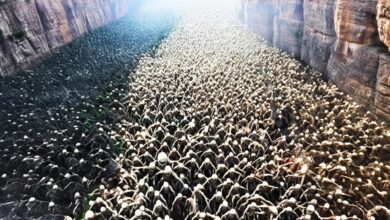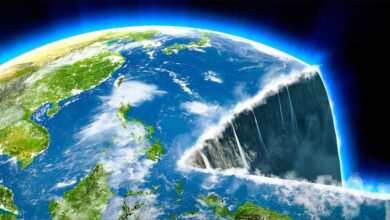Who Killed the Colorado River?

Delves deeply into the tragic decline of the Colorado River, once a vital source of water for the American Southwest, but now severely depleted due to a combination of historical mismanagement, modern-day consumption, and environmental changes.
The Colorado River has been a central feature of the American Southwest for centuries, carving canyons, feeding ecosystems, and supplying water to millions of people. It starts in the Rocky Mountains of Colorado, flowing through five U.S. states, and once emptied into the Gulf of California in Mexico. The river’s flow was so vast that it could have filled 300 million Olympic-sized swimming pools each year, making it an essential lifeline for both human populations and wildlife. However, this once-mighty river has been reduced to a shadow of its former self. By the 1960s, the river was no longer reliably reaching its natural endpoint in Mexico.

The Colorado River Compact and Water Management:
The beginning of the river’s problems can be traced to 1922, when representatives from seven U.S. states met in Santa Fe, New Mexico, to divide the river’s water among themselves. This agreement, known as the Colorado River Compact, was a landmark moment, as it set the stage for the future management of the river’s resources. The compact allotted water based on an estimated flow of 16.4 million acre-feet per year. However, the actual flow of the river has consistently fallen short of that estimate, averaging only 12.4 million acre-feet annually in recent decades.
The compact’s creators failed to account for future water shortages, and, notably, no representatives from Mexico or Native American tribes—both of which share the river’s resources—were included in the discussions. This imbalance in water allocation set the stage for decades of overuse, as the U.S. government and various states relied on an overestimation of the river’s flow.
Dams and Reservoirs:
The second key factor in the river’s demise is the construction of numerous dams along its course, beginning with the Imperial Dam in 1938. Over a period of 65 years, 15 major dams were built, each altering the flow of the river and creating large reservoirs to store water. While these dams provide benefits like flood control, hydroelectric power, and water storage for urban areas and agriculture, they also come with severe environmental costs. The reservoirs created by these dams expose vast amounts of water to evaporation. In fact, around 11% of the river’s flow evaporates each year in these reservoirs, significantly reducing the amount of water that continues downstream.
The still, warm water of reservoirs evaporates much more quickly than the moving water of a river, meaning that these reservoirs are major contributors to the depletion of the river’s flow.

The Central Arizona Project and Urban Consumption:
Next, the video discusses the Central Arizona Project (CAP), a massive 330-mile canal that diverts water from the Colorado River to feed the growing needs of cities like Phoenix and Tucson. This canal, which pushes water uphill via 14 pumping stations, consumes nearly one trillion gallons of water each year. Arizona, California, and other Western cities have expanded rapidly, with a significant portion of their water consumption coming from the Colorado River. In fact, 18% of the river’s water is used by urban areas and industries, fueling large metropolitan areas in a region known for its arid climate.
Agriculture as a Major Culprit:
The most surprising and devastating culprit, however, is agriculture, particularly in the Imperial Valley of California. This region alone consumes 52% of the Colorado River’s water, much of it used for growing crops like alfalfa, which is then fed to cattle. While much of the agriculture looks like it’s producing food for human consumption, most of the crops are actually grown for livestock. What’s worse, around 20% of the alfalfa grown here is exported to other countries like the Middle East and Asia. This is an example of how the U.S. is effectively exporting its limited water resources, by growing cattle feed for overseas markets.
Furthermore, the water rights system in the U.S. encourages wasteful practices. Under the use it or lose it system, farmers must use their entire water allotment each year to avoid losing their water rights in the future. As a result, practices like flood irrigation are common, where fields are submerged in water to ensure that every drop of the allotted water is used, even if the crops don’t need it.
Environmental Impact and Restoration Efforts:
As the Colorado River dwindles, its environmental impacts have been catastrophic. The Salton Sea, a large body of water in California, is a direct result of agricultural runoff from the Colorado River. What was once a thriving, dynamic water system is now a dry, polluted wasteland in many places. The river’s delta, which used to be a rich ecosystem supporting marshes, estuaries, and wildlife, is now largely dry, with little left of the ecosystem that once thrived there.
However, in a glimmer of hope, restoration projects on the Mexican side of the border have made strides to bring some life back to the river’s delta. Through binational agreements, environmental organizations have been able to periodically release water into the delta, revitalizing parts of the landscape that had been desiccated for decades. These efforts are showing promising results, with more birds and wildlife returning to the area.
Challenges and Future Outlook:
While restoration is underway, the challenges the Colorado River faces are still immense. The story of the river’s decline is a complex web of overuse, poor management, and a failure to consider the long-term environmental costs of human activity. The restoration projects in Mexico are an example of what’s possible when people work together to reverse some of the damage, but the river still faces significant hurdles.
The future of the Colorado River hinges on rethinking water use across the American Southwest. There needs to be a broader acknowledgment that the river’s resources are finite and that water management policies must adapt to reflect this reality. The hope is that, with ongoing efforts and cooperation between states, Mexico, Native American tribes, and environmental organizations, the Colorado River can once again flow freely to the Gulf of California, supporting the ecosystems and communities that depend on it.
Encouraging viewers to reflect on their own relationship with water and consider the broader implications of how we use and conserve this precious resource. The Colorado River’s story is still evolving, and while there is no single solution to its problems, there is hope that with continued effort, the river could once again thrive.








